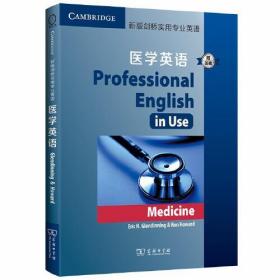
新版剑桥实用专业英语:医学英语(附答案)
¥ 38.1 5.6折 ¥ 68 全新
库存50件
河北保定
认证卖家担保交易快速发货售后保障
作者Eric Glendinning
出版社商务印书馆
出版时间2020-05
版次1
装帧其他
货号9787100183208
上书时间2024-12-19
- 在售商品 暂无
- 平均发货时间 27小时
- 好评率 暂无
- 最新上架
商品详情
- 品相描述:全新
图书标准信息
- 作者 Eric Glendinning
- 出版社 商务印书馆
- 出版时间 2020-05
- 版次 1
- ISBN 9787100183208
- 定价 68.00元
- 装帧 其他
- 开本 128开
- 纸张 胶版纸
- 页数 180页
- 字数 100千字
- 【内容简介】
- 《新版剑桥实用专业英语:医学英语(附答案)》是为学习医学且具有中高级英文水平的学习者设计的,它提供的医学专业英语,有助于提高学习者对医学期刊、书籍的阅读水平,帮助医学工作者或学生参加医学国际会议,或到讲英语的国家进行短期海外实习。此书可作为自学的学习资料,也可以作为课堂教学的课本,既可一对一来学习,还可以学习小组的形式来学习。
- 【作者简介】
-
埃里克·格伦迪宁是应用语言研究所所长,也是一些专业英语教科书的作者。
罗恩•霍华德是应用语言研究所远程学习的发展协调员。他对教师教育课程的主要贡献是ESP,特别是医学英语和计算机辅助语言学习,他曾为中国、波兰、匈牙利、埃及和古巴的ESP教师办过讲习班。 - 【目录】
-
INTRODUCTION 8
BASICS
1 Health and illness 10
A Asking about health
B Sickness
C Recovery
2 Parts of the body 1 12
A Parts of the body
B Referring to parts of the body
C Describing radiation of pain
3 Parts of the body 2 14
A The abdomen
B The chest
C The pelvis
4 Functions of the body 16
A Eating
B The fifi ve senses
C Other functions
D Less common functions
MEDICAL AND PARAMEDICAL
PERSONNEL AND PLACES
5 Medical practitioners 1 18
A Practitioners
B Specialties
C Choosing a specialty
6 Medical practitioners 2 20
A Hospital staff
B Medical teams
C Shifts
7 Nurses 22
A Nursing grades
B Support workers
C Specialization
D The nurse’s role
8 Allied health professionals 24
A Community health
B Technicians
C Prosthetists and orthotists
D Opticians
9 Hospitals 26
A Introduction to a hospital
B Outpatients
C Inpatients
10 Primary care 28
A The National Health Service
B The practice team
C A GP’s day
EDUCATION AND TRAINING
11 Medical education 1 30
A Medical education in the UK
B Extract from an undergraduate prospectus
C A student’s view
12 Medical education 2 32
A The Foundation Programme
B People in medical education
C Medical qualififi cations
13 The overseas doctor 34
A Types of registration
B PLAB
C PLAB stations and advice
SYSTEMS, DISEASES AND SYMPTOMS
14 Symptoms and signs 36
A Describing problems
B Presentation
C Talking about symptoms
15 Blood 38
A Full blood count
B Anaemia
C Pernicious anaemia
16 Bones 40
A Bones
B Fractures
C Treatment of fractures
17 Childhood 42
A Milestones
B Common infectious diseases
C Coeliac disease
18 The endocrine system 44
A Excess and defifi ciency
B Negative feedback systems
C Goitre
D A letter of referral
19 The eye 46
A Parts of the eye
B Examination of the eye
C Retinopathy
20 The gastrointestinal system 48
A Examination of the abdomen
B The faeces
21 Gynaecology 50
A The female reproductive system
B Menstruation
C A gynaecological consultation
D Contraception
22 The heart and circulation 1 52
A Shortness of breath
B Heart rhythm
C Heart failure
23 The heart and circulation 2 54
A Physical examination
B Examining the heart and circulation
24 Infections 56
A Fever
B Microorganisms
C Source and spread of infection
25 Mental illness 58
A Psychiatric disorders
B Substance abuse
C Affective disorders
D Neurotic and stress-related disorders
E Other types of functional disorder
26 The nervous system 1 60
A Sensory loss
B Motor loss
C Loss of consciousness
27 The nervous system 2 62
A The motor system
B Tendon reflfl exes
C Coma
28 Oncology 64
A Neoplasms
B Symptoms and signs of malignancy
C Treatment of tumours
29 Pregnancy and childbirth 66
A Childbirth
B Labour
C Presentation and lie
30 The respiratory system 68
A Cough
B Auscultation
31 The skin 1 70
A Some types of skin lesion
B Rashes
32 The skin 2 72
A Injuries to the skin
B Case report
C Sores
33 The urinary system 74
A Urinary symptoms
B Urinalysis
INVESTIGATIONS
34 Basic investigations 76
A Ophthalmoscopy
B Blood pressure
C Taking blood
35 Laboratory tests 78
A A Microbiology test request form
B A Biochemistry and Haematology lab report
C Terms used to describe lab results
36 Endoscopy 80
A Functions of endoscopy
B Enteroscopy
C Report of a diagnostic endoscopy
37 X-ray and CT 82
A Radiography and radiology
B X-ray examination
C Computed Tomography
38 MRI and ultrasound 84
A Magnetic Resonance Imaging (MRI)
B Ultrasound
C Preparing for medical imaging
D Describing medical imaging
39 ECG 86
A Uses of an ECG
B ECG procedure
C A normal ECG
TREATMENT
40 Medical treatment 88
A Prescriptions and drugs
B The British National Formulary
41 Surgical treatment 90
A The operating theatre
B Instruments
C The operation
D An operation report
42 Therapies 92
A Radiotherapy and chemotherapy
B A day in the life of a physiotherapist
C Cognitive Behavioural Therapy
PREVENTION
43 Screening and immunization 94
A Screening
B Common screening tests
C Immunization for travellers
EPIDEMIOLOGY
44 Epidemiology 96
A Rates
B Incidence and prevalence
C Association and causation
ETHICS
45 Medical ethics 98
A GMC guidelines
B Bioethical issues
C Assisted dying
RESEARCH
46 Research studies 100
A Case-control studies
B Cohort studies
C Trials
D Variables
TAKING A HISTORY
47 Taking a history 1 102
A A full case history
B Personal details
C Talking about pain
48 Taking a history 2 104
A Drug history
B Family history
C Social and personal history
49 Taking a history 3 106
A Reviewing the systems
B Asking about the central nervous system
C Patient ideas, concerns and expectations
D Phrasal verbs in history-taking
EXAMINATION
50 Physical examination 108
A Examining a patient
B Giving instructions
51 Mental state examination 110
A Some symptoms of psychiatric disorders
B Mood
C Typical questions from a mental state examination
EXPLANATION
52 Explaining diagnosis and management 112
A Explanations
B Using lay terms in explanations
C An explanation of angina
53 Discussing treatment 114
A Offering options
B Advising a course of action
C Advising patients to avoid something
D Warnings
54 Giving bad news 116
A Principles of giving bad news
B A consultant medical oncologist’s report
PRESENTATIONS
55 Data presentation 1 118
A Referring to a table or fifi gure
B Comparing variables
C Approximating
56 Data presentation 2 120
A Line graphs
C Describing trends
57 Research articles 122
A The structure of a research article
B Objectives
C Main fifi ndings
58 Abstracts 124
A Structured abstracts
B The BMJ abstract
59 Conference presentations 126
A The structure of a presentation
B The introduction
C Signalling
D The conclusion
60 Case presentations 128
A Sections of a case presentation
B Bedside presentation
C Slides
Appendix I 130
Parts of the body
Appendix II 131
Medical abbreviations
Appendix III 143
Types of medication
Appendix IV 144
Symptoms and pain
Appendix V 145
Verbs used in instructions
Appendix VI 146
Lay terms and defifi nitions
Answer key 147
Index 168
点击展开
点击收起
— 没有更多了 —












以下为对购买帮助不大的评价